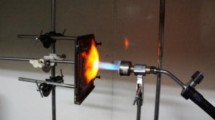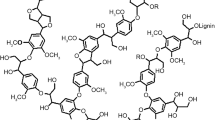Abstract
Intumescent fire-retardant coatings are widely applied as they combine designable aesthetics and fire protection without compromising substrate properties. When exposed to heat, intumescent fire-retardant coatings expand and build an insulating char. This study presents an investigation of the char by addition of kaolinite, barite, and titania as functional fillers in intumescent coatings. Expansion experiments at 400°C with custom build image analysis showed that kaolinite inhibited (0.03 mm/s, expansion factor ≈ 7), whereas barite acted synergistically on the expansion ability (0.59 mm/s, expansion factor ≈ 85). The resulting char density and the visual inspection showed that barite char was less compact, with cracks and voids. Evaluation of fire performance by single burning item tests resulted in Euroclass C for the barite system and Euroclass A2/B for the titania system. Post-heating chars demonstrated poor thermostability of barite char, and subsequent FTIR spectroscopy revealed that titania char formed the thermostable titanium pyrophosphate. Further inspection of the titania char revealed a uniform closed cell structure with mean bubble sizes of 26–56 µm. Titania coating expands rapidly (0.37 mm/s, expansion factor ≈ 60) and forms a structurally stable tumescent char with a compact and uniform porous structure exhibiting resistance to char oxidation at sustained heating.






Similar content being viewed by others
References
Ahrens, M, Evarts, B, National Fire Protection Agency US, “Fire Loss in the United States During 2019.” NFPA No. FLX10. https://www.nfpa.org/News-and-Research/Data-research-and-tools/US-Fire-Problem/Fire-loss-in-the-United-States (2020)
Ng, CMY, Chow, WK, “A Brief Review on the Time Line Concept in Evacuation.” Int. J. Archit. Sci., 7 (1) 1–13 (2013)
Camino, G, Costa, L, Martinasso, G, “Intumescent Fire-Retardant Systems.” Polym. Degrad. Stab., 23 (4) 359–376 (1989)
Alongi, J, Han, Z, Bourbigot, S, “Intumescence: Tradition Versus Novelty. A Comprehensive Review.” Prog. Polym. Sci., 51 28–73 (2015)
Puri, RG, Khanna, AS, “Intumescent Coating: A Review on Recent Progress.” J. Coat. Technol. Res., 14 (1) 1–20 (2017)
Bourbigot, S, Le Bras, M, Delobel, R, “Carbonization Mechanisms Resulting from Intumescence Association with the Ammonium Polyphosphate-Pentaerythritol Fire Retardant System.” Carbon, 31 (8) 1219–1230 (1993)
Bourbigot, S, Le Bras, M, Delobel, R, Bréant, P, Trémillon, J-M, “Carbonization Mechanisms Resulting from Intumescence Part II. Association with the Ammonium Polyphosphate-Pentaerythritol Fire Retardant System.” Carbon, 33 (3) 283–294 (1995)
Weil, ED, “Fire-Protective and Flame-Retardant Coatings—A State-of-the-Art Review.” J. Fire Sci., 29 (3) 259–296 (2011)
Hull, TR, Witkowski, A, Hollingbery, L, “Fire Retardant Action of Mineral Fillers.” Polym. Degrad. Stab., 96 (8) 1462–1469 (2011)
Nasir, KM, Sulong, NHR, Johan, MR, Afifi, AM, “Synergistic Effect of Industrial-and Bio-Fillers Waterborne Intumescent Hybrid Coatings on Flame Retardancy, Physical and Mechanical Properties.” Prog. Org. Coat., 149 105905 (2020)
Scharf, D, Nalepa, R, Heflin, R, Wusu, T, “Studies on Flame Retardant Intumescent Char: Part 1.” Fire Saf. J., 19 (1) 103–117 (1992)
Mariappan, T, Agarwal, A, Ray, S, “Influence of Titanium Dioxide on the Thermal Insulation of Waterborne Intumescent Fire Protective Paints to Structural Steel.” Prog. Org. Coat., 111 67–74 (2017)
Lide, DR, Handbook of Chemistry and Physics. 74th edn, CRC Press, (1993–1994)
Cheng, H, Liu, Q, Yang, J, Ma, S, Frost, RL, “The Thermal Behavior of Kaolinite Intercalation Complexes—A Review.” Thermochim. Acta, 545 1–13 (2012)
Ullah, S, Ahmad, F, Shariff, AM, Bustam, MA, “Synergistic Effects of Kaolin Clay on Intumescent Fire Retardant Coatings Composition for Fire Protection of Structural Steel.” Polym. Degrad. Stab., 110 91–103 (2014)
Fan, F-q, Xia, Z-b, Li, Q-y, Li, Z, “Effect of Inorganic Fillers on Shear Viscosity and Fire Retardant Performance of Waterbourne Intumescent Coating.” Prog. Org. Coat., 76 844–851 (2013)
Bodzay, B, Bocz, K, Bárkai, Z, Marosi, G, “Influence of Rheological Additives on Char Formation and Fire Resistance of Intumescent Coatings.” Polym. Degrad. Stab., 96 355–362 (2011)
EN 13238:2001, "Reaction to fire tests for building products—conditioning procedures and general rules for selection of substrates."
Rasband, WS, ImageJ, U. S. National Institutes of Health, Bethesda, Maryland, USA. https://imagej.nih.gov/ij/. (1997–2018)
EN 13823:2010, "Reaction to fire tests for building products—building products excluding floorings exposed to the thermal attack by single burning item."
EN 13501-1 + A1, "Fire classification of construction products and building elements—part 1: classification using data from reaction to fire tests."
Petit, S, Righi, D, Madejová, J, “Infrared Spectroscopy of NH4+-Bearing and Saturate Clay Minerals: A Review of the Study of Layer Charge.” Appl. Clay Sci., 34 22–30 (2006)
Socrates, G, Infrared and Raman Characteristic Group Frequencies Tables and Charts. 3rd edn, Wiley, ISBN 978-0-470-09307-8 (2001)
Thomas, LC, Chittenden, RA, “Characteristic Infrared Adsorption Frequencies of Organophosphorus Compounds II P-O-(X) Bonds.” Spectrochim. Acta, 20 489–502 (1964)
Thomas, LC, Chittenden, RA, “Characteristic Infrared Adsorption Frequencies of Organophosphorus Compounds I, the Phosphoryl (P=O) Group.” Spectrochim. Acta, 20 467–487 (1964)
Thomas, LC, Chittenden, RA, “Characteristic Infrared Adsorption Frequencies of Organophosphorus Compounds VII, Phosphorus Ion.” Spectrochim. Acta, 26A 781–800 (1970)
Lipinska-Kalita, KE, Kruger, MB, Carlson, S, Krogh Andersen, AM, “High-Pressure Studies of Titanium Pyrophosphate by Raman Scattering and Infrared Spectroscopy.” Physica B Condens. Matter, 337 (1–4) 221–229 (2003)
Frost, RL, Vassallo, AM, “The Dehydroxylation of the Kaolinite Clay Minerals Using Infrared Emission Spectroscopy.” Clays Clay Min., 44 (5) 635–651 (1996)
Veculíková, L, Plevová, E, Vallová, S, Koutník, I, “Characterization and Differentiation of Kaolinites from Selected Czech Deposites Using Infrared Spectroscopy and Differential Thermal Analysis.” Acta Geodyn. Geomater., 8 (1161) 59–67 (2011)
Jagtap, SB, Pande, AR, Gokarn, AN, “Effect of Catalysts on the Kinetics of the Reduction of Barite by Carbon.” Ind. Eng. Chem. Res., 29 795–799 (1990)
Camino, G, Costa, L, Luda, MP, “Mechanistic Aspects of Intumescent Fire Retardant Systems.” Makromol. Chem Macromol. Symp., 74 71–83 (1993)
Rosas, JM, Ruiz-Rosas, R, Rodrígues-Mirasol, J, Cordero, T, “Kinetic Study of Oxidation Resistance of Phosphorus-Containing Activated Carbons.” Carbon, 50 1523–1537 (2012)
Gu, J-W, Zhang, G-C, Dong, S-L, Zhang, Q-Y, Kong, J, “Study on Preparation and Fire-Retardant Mechanism Analysis of Intumescent Flame-Retardant Coatings.” Surf. Coat. Tech., 201 7835–7841 (2007)
Aziz, H, Ahmad, F, “Effects from Nano-Titanium Oxide on the Thermal Resistance of An Intumescent Fire Retardant Coating for Structural Applications.” Prog. Org. Coat., 101 431–439 (2016)
Acknowledgments
This work is partly funded by the Innovation Fund Denmark under File No 9065-00233B.
Author information
Authors and Affiliations
Contributions
IH-B contributed to conceptualization, formal analysis, investigation, software, methodology, validation, writing—original draft, writing—review and editing. AVP contributed to formal analysis, investigation, methodology, software, writing—review and editing. UA contributed to formal analysis, investigation, software, writing—review and editing. JR contributed to conceptualization, funding, resources, supervision, writing—review and editing. MH contributed to conceptualization, funding, resources, project administration, supervision, writing—review and editing.
Corresponding author
Ethics declarations
Conflict of interest
There are no conflicts of interest to declare.
Additional information
Publisher's Note
Springer Nature remains neutral with regard to jurisdictional claims in published maps and institutional affiliations.
Supplementary Information
Below is the link to the electronic supplementary material.
Rights and permissions
About this article
Cite this article
Hansen-Bruhn, I., Poulsen, A.V., Abildgaard, U. et al. Effect of titania, barite, and kaolinite fillers on char layer formation in water-based intumescent fire-retardant coatings. J Coat Technol Res 19, 1067–1075 (2022). https://doi.org/10.1007/s11998-021-00585-8
Received:
Revised:
Accepted:
Published:
Issue Date:
DOI: https://doi.org/10.1007/s11998-021-00585-8




